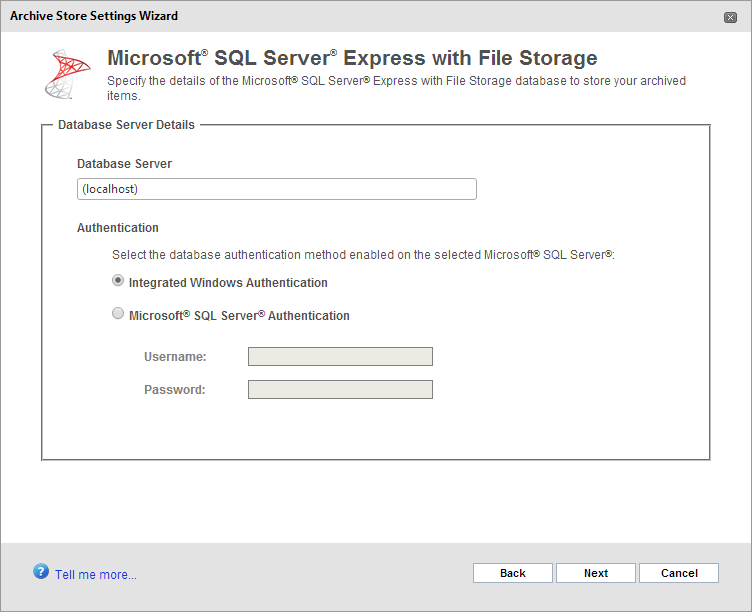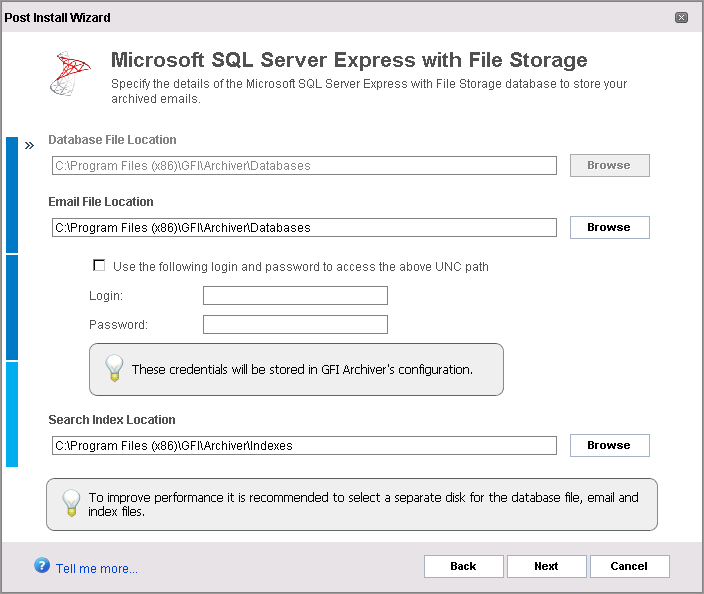Configuring Archive Store - SQL Server®
If you have opted to use a Microsoft® SQL Server, Microsoft® SQL Server with File Storage or SQL Server® Express with File Storage, you will now be guided to set up a new Archive Store settings.
NOTE
Ensure SQL Server® is installed in Mixed Mode authentication and TCP IP is enabled.

Archive Store creation: Select database
1. In the Database Server Details screen, choose an SQL Server® from the list of automatically discovered servers or manually provide the details.
| Option | Description |
|---|---|
| Select the database server to use to store the archived emails. |
Enables you to select a SQL Server® from the list of discovered Microsoft® SQL Servers. Click Recheck to recheck for any servers that might have come online since the page loaded. |
| Manually specify the database server to use to archive your emails. |
Choose this option to disregard the list of discovered Microsoft® SQL Servers and to specify the details of the server used for your Archive Store. |
2. Click Next to continue.
3. If, in the previous screen, you chose to manually specify the details used to store your archived emails, provide the Microsoft® SQL Server database name in the Database Server field. If a database server was selected, continue with the next step.
4. Select the authentication method used to connect to the selected SQL Server®.
| Option | Description |
|---|---|
| Integrated Windows Authentication |
Uses the login credentials of the currently logged on user to access the SQL Server®. Keying in a username and a password is not required. |
| Microsoft SQL ServerA Microsoft relational database management system. Authentication |
Uses the username and password provided in the Username and Password fields to access the SQL Server®. |
5. Click Next to continue.
6. Provide the paths for the SQL Server® data (.mdf) and log (.ldf) files. If an existing database was selected, skip to the next step.
| Option | Description |
|---|---|
| Use the default path as defined in the Microsoft SQL Server |
Instructs GFI Archiver to use the default paths configured within SQL Server®. Uncheck this option to configure alternate paths. |
| Data file location |
Defines the location used by GFI Archiver to store data files. Key in or click Browse… to select the path. |
| Use the same path for both data file and log file. |
Instructs GFI Archiver to use the path in the Data & Log File Location text box as the location for the Log file. Uncheck this option to key in a custom log file location. |
| Log File Location |
Defines the location used by GFI Archiver to store the log files. Key in or click Browse… to select the path. |
7. Click Next to continue.

Archive Store creation: Select locations
8. Provide the file locations required for the type of selected SQL Server® type.
NOTE
Some options are not selectable depending on the chosen SQL Server® type.
For example, selecting Microsoft SQL Server with File Storage disables Database File Location and Email File Location options.
| Option | Description |
|---|---|
| Email file location |
Defines the location where the email data will be located. Key in or click Browse… to select a location where to store this file. NOTE UNC paths are allowed. |
| Use the following login and password to access the above UNC path |
Enable this option to allow input in the Login: and Password: fields. The credentials keyed in will be used to access the UNC paths selected. |
| Search Index location |
Defines the location where the email search index will be located. Key in or click Browse… to select a location where to store this file. NOTE UNC paths are allowed provided that the Search service has read/write access to the location. For more information refer to Configuring Index File Location Credentials. |
9. Click Next to continue.
10. (Optional) Check Create a new Archive Store now to let GFI Archiver create the first archive store. A welcome email is sent by GFI Archiver to confirm that the new archive store has been created.
11. Click Finish.